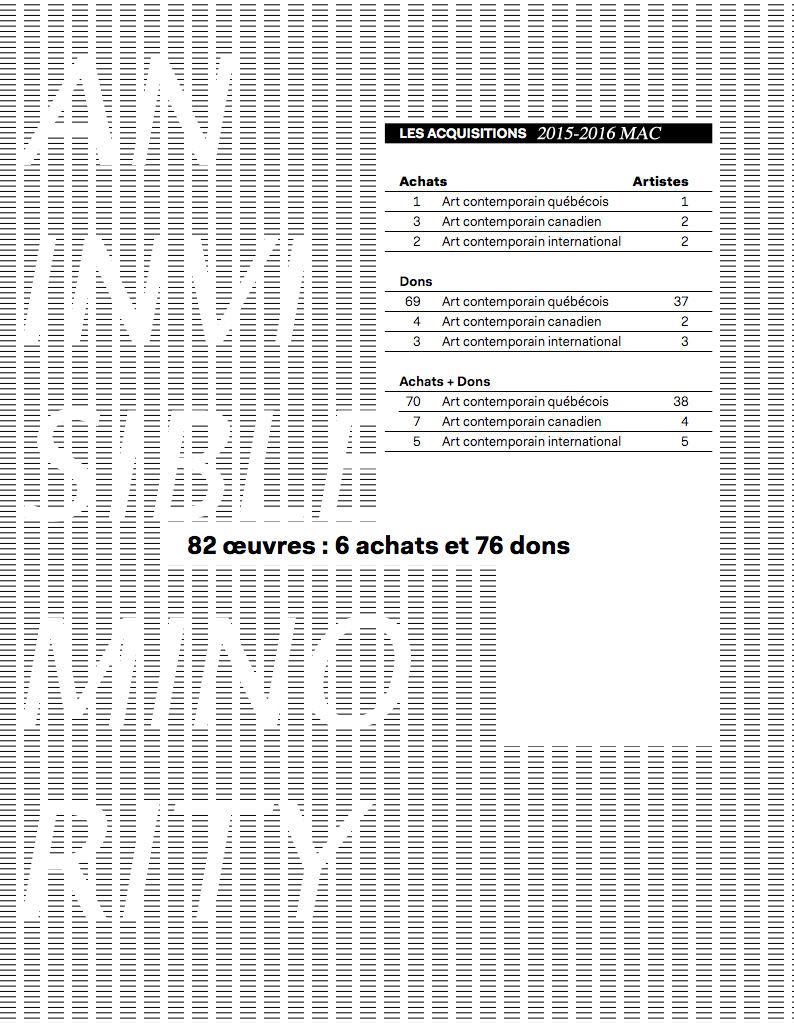an installation by Stanley Février
January 24 - 27, 2018
EXHIBITION:
I am invisible, understand, simply because people refuse to see me.
Ralph Ellison, Invisible man, 1952
The invisibility at issue here stems from a critical assessment of museum institutions and reflects on the system of recognition within the Quebecer contemporary art milieu. The notion of identity develops as an ensemble of data which makes it possible for an individual, for a group, to form themselves, and also to differentiate themselves from others (Norbert, 1991). Through my background, I am obliged to produce art which is not quite Quebecer: it is so-called ethnic art. To call into question the gaze of others upon me is to analyze my position within my artistic practice as well as within the art world. This gaze underlines issues related to diversity, to various forms of institutional instrumentalisation and to the contemporary devices of art related to the exclusion of the practices of Black visible minority artists.
Positioning itself within the critical space carved out by Fred Wilson, my work calls into question the absence of artists from visible minorities within museum collections, namely at the Musée d’art contemporain de Montréal. Through his work, Mining the Museum, Wilson offers a new perspective by revealing the “other” history of the museum institution, that of Baltimore’s ethnic communities. Within a similar frame of thinking, through Analyse de la collection du Musée d’art contemporain de Montréal à partir du critère de la diversité ethnoculturelle transposée dans une installation (Analysis of the collection of Musée d’art contemporain de Montréal based on the criterion of ethnocultural diversity transposed into an installation), I question and demonstrate the existence of inequalities in terms of national and international identities within museum collections, in particular at the Musée d’art contemporain de Montréal. Thus, I interrogate the issue of cultural identity within the permanent collection of the Musée d’art contemporain de Montréal. Do issues of homogeneity and monoculture exist within cultural institutions? How do we navigate this dialog and bridge the gap between cultural institutions and so-called artists of “diversity?”
_______________________________
Elias Norbert, La société des individus, Fayard, Paris, 1991
«Invisible by nature is what, escaping the capture of the eye, is deemed irrepresentable. The list of these objects is long, from the wind, of which we see only the effects, to the Platonic ideas which are accessible only to a contemplation which has nothing visual».* (François Lecercle, «Préambule», in Visible/Invisible au théâtre, Textuel, Revue de l’UFR «Sciences des textes et documents» de Paris 7, n° 36, 1999, pp. 5-23, p. 15).
*Translation by Artexte
CONFERENCE:
The presence of Black and Indigenous artists in the AGAC member contemporary art galleries in Montreal in 2016 and 2017
This statistical study discusses the presence of Black and Indigenous artists in Montreal galleries which were members of AGAC in 2016 and 2017. It stems from a first statistical inquiry entitled, The under-representation of artists who are immigrants in contemporary art galleries who are members of AGAC in Montreal (La sous-représentation des artistes issus de l’immigration dans les galeries d’art contemporain membres de l’AGAC à Montréal) of which the results were presented at l’Université de Montréal in February 2017 during the 19th colloquium for students and recent alumni organized by the ethnic studies centre, Centre d’études ethniques des universités montréalaises. This presentation is specifically focused on the results pertaining to Black and Indigenous artists. While these two groups of artists represent a small number of individuals, 7 out of 459 in 2016, the detailed analysis of the results showcases the challenges relating to their recognition.
Biographical Information
Stanley Février is currently completing a master’s degree in visual and media art at l’Université du Québec à Montréal (UQAM). He is interested in modern tragedies and socio-political issues around the valuation of life in the 21st century in the context of globalization.
Filipa Esteves holds a master’s degree in art history from Université de Montréal and is interested in cultural representation in contemporary art. She is a recipient of the Images for Peace Award (Bourse Images pour la paix) from Université de Montréal.
